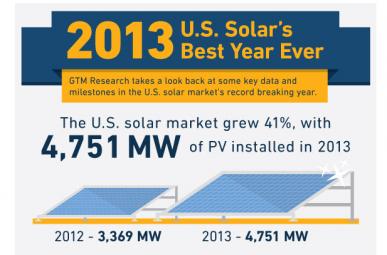
To see the full infographic, go to greentechmedia.com.
You may have heard about the recent 60 Minutes segment that inexplicably reported the cleantech sector was in steep decline. There are quite a few reports out there breaking down the many fallacies of that segment, with most correctly concluding the sector is not dead, it is in fact booming and evidence of that surging momentum is everywhere you look. Consider these five examples that show just how good things are for cleantech these days:
1. The solar industry is booming.
The facts are unequivocal: the solar industry is alive and well. According to a new report and infographic released this week by Greentech Media Research and the Solar Energy Industry Association (SEIA), 2013 was a banner year.
The Wall Street Journal also recently reported that investors are more enthusiastically embracing solar stocks again, siting “an industry shakeout of the past few years and falling costs of producing and installing solar-power systems” as the reason for a “recent big gains in the stocks.”
The handful of solar companies that didn’t make it tend to grab more headlines. But on the whole, the solar industry has grown by leaps and bounds in terms of job creation, generating capacity, and investor confidence.
2. Federal grants are leading to incredibly successful startups.
Not only is Tesla Motors one of the most successful cleantech startups in the world, they are one of the most successful startups of any sector. They recently announced plans to invest $2 billion in a large-scale factory to produce cheaper batteries, and stock shares soared after news of the company’s robust production outlook. They must be doing something right to afford such robust growth, and none of this would have been possible without the Department of Energy loan program that helped get them off the ground.
And though Tesla is rightly held up as an example of the United States’ commitment to the advancement of clean technologies (to say nothing of their cars), they’re hardly alone. You can find examples of startups receiving federal loans to help jumpstart tremendously successful companies all over America.
3. States are paving the way for more cleantech success, too.
Take a look at New York, where Governor Cuomo recently announced an initiative to provide an additional $30 million to stimulate more large-scale solar and biogas projects in the New York City area. Meanwhile, in Arizona, state regulators are working on smart energy measures that would both lay a foundation for a strong rooftop solar industry while still allowing utilities to charge fair rates to solar rooftop customers.
Stories like these are indicative of the national trend – states increasingly recognize the value in supporting the robust cleantech sector because advancements in clean energy are good for people, business and the environment. And you can expect to see more such examples of state-sponsored, market-based solutions that benefit the public and private sectors alike as word about successful models like these spread.
4. More people are embracing cleantech.
Of course, even favorable market conditions wouldn’t amount to much without strong demand for cleantech. Fortunately, new data suggests that after years of fluctuations, customers are increasingly interested. Solar energy, wind energy, and hybrid and electric cars all saw a rebound in interest compared to prior-year levels.
Google’s recent $3.2 billion purchase of Nest Labs, the company responsible for transforming “unloved” home products, such as thermostats and smoke detectors, into beautiful, smart appliances, is another indicator that more people are embracing cleantech. By purchasing Nest, Google was simply reacting to a market signal from customers whose interest (and investments) in smart, innovative home energy management systems have shown a significant increase over the past few years.
5. Cleantech costs are falling.
Lower costs play a huge factor in the cleantech industry’s success, according to the Department of Energy:
- The cost of solar panels has dropped 75 percent since 2008.
- The cost of LED lights fell 85 percent in that same time frame.
- Electric vehicle batteries cost 50 percent less today than they did four years ago.
There’s no question there is still much work to be done. The United States is at a crossroads, and there are still many policy, regulatory, and market barriers that EDF is working diligently to help remove so that an even broader-scale adoption of cleantech may be achieved. A continued investment in cleantech will pave the way for a sustainable, clean energy future that grows our economy, helps families save money, and cuts pollution that causes climate change.
So let’s give credit where it’s due – the cleantech sector has taken off, whether the news reports it or not.
This commentary originally appeared on our EDF Voices blog.









